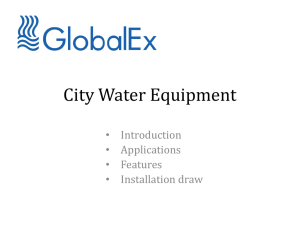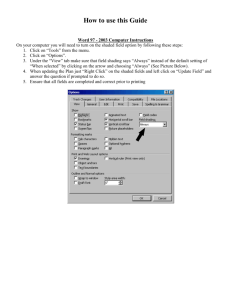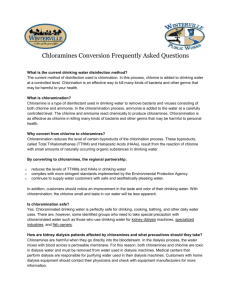2015 Chlorine Burnout Information Overview
advertisement
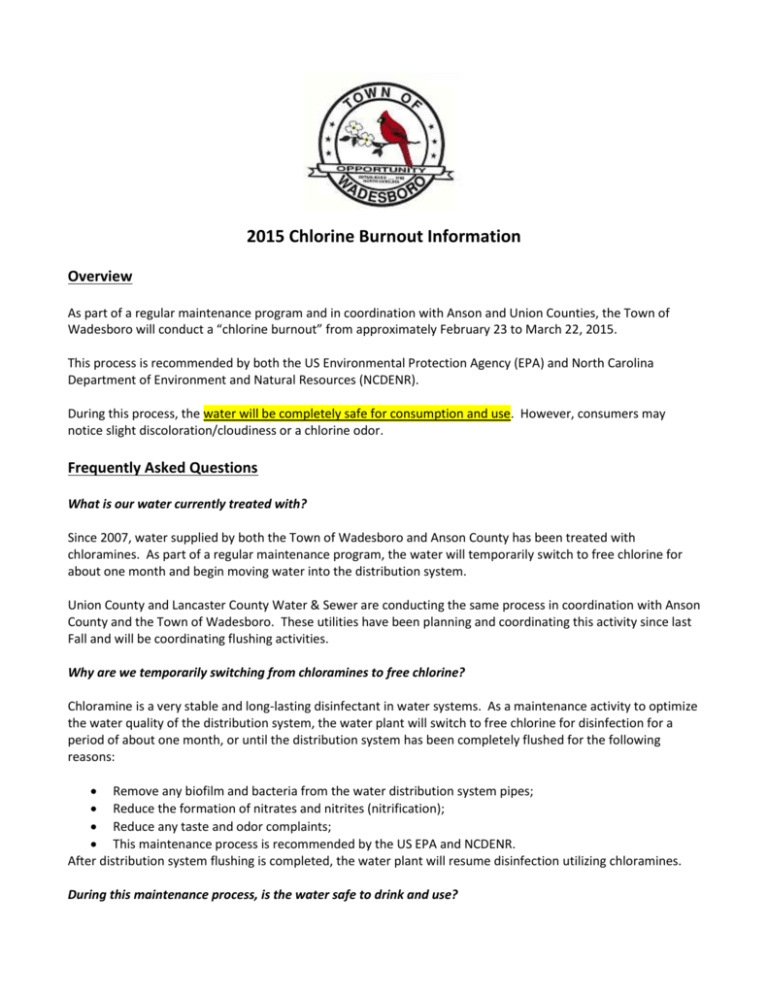
2015 Chlorine Burnout Information Overview As part of a regular maintenance program and in coordination with Anson and Union Counties, the Town of Wadesboro will conduct a “chlorine burnout” from approximately February 23 to March 22, 2015. This process is recommended by both the US Environmental Protection Agency (EPA) and North Carolina Department of Environment and Natural Resources (NCDENR). During this process, the water will be completely safe for consumption and use. However, consumers may notice slight discoloration/cloudiness or a chlorine odor. Frequently Asked Questions What is our water currently treated with? Since 2007, water supplied by both the Town of Wadesboro and Anson County has been treated with chloramines. As part of a regular maintenance program, the water will temporarily switch to free chlorine for about one month and begin moving water into the distribution system. Union County and Lancaster County Water & Sewer are conducting the same process in coordination with Anson County and the Town of Wadesboro. These utilities have been planning and coordinating this activity since last Fall and will be coordinating flushing activities. Why are we temporarily switching from chloramines to free chlorine? Chloramine is a very stable and long-lasting disinfectant in water systems. As a maintenance activity to optimize the water quality of the distribution system, the water plant will switch to free chlorine for disinfection for a period of about one month, or until the distribution system has been completely flushed for the following reasons: Remove any biofilm and bacteria from the water distribution system pipes; Reduce the formation of nitrates and nitrites (nitrification); Reduce any taste and odor complaints; This maintenance process is recommended by the US EPA and NCDENR. After distribution system flushing is completed, the water plant will resume disinfection utilizing chloramines. During this maintenance process, is the water safe to drink and use? Yes. The water is safe to drink and use as normal. Customers may notice slight discoloration/cloudiness or chlorine odor, but it is safe to use. Water users sensitive to chlorine or chloramine should take normal precautions. What effects may customers observe during this maintenance/flushing process? A customer may see some of the following during this maintenance process: A slight discoloration or cloudiness in the water; A slight chlorine odor or taste; Minor fluctuations in water pressures while flushing is occurring; Minor discolorations in the water due to flushing the system; Utility crews operating the fire hydrants to flush the system. Many customers may not notice any change in the water. Critical Users such as hospitals, dialysis groups, pet/aquatic/pond companies, companies that use water for processing, and other water users sensitive to chloramines or free chlorine should consult with their professionals about their internal treatment procedures. What should customers do if they experience any discoloration or odor? If the water is discolored or cloudy, flush the water through an outside spigot or tub faucet for a few minutes to clear. By running the water through a spigot or tub faucet, the problem clears faster and if any debris particles have been stirred by flushing, it will not clog faucet strainers. Why switch to free chlorine for this maintenance activity? By temporarily switching to free chlorine, it removes biofilm and any other bacteria that may have developed in the water distribution system while on chloramines. Why not stay with free chlorine as a treatment process? While chlorine is a stronger disinfectant, it reacts with organic matter found naturally in our raw water supply and produces disinfectant byproducts such as trihalomethanes (THMs) and haloacetic acids (HAAs). Free chlorine also does not last as long in the distribution system. Chloramine is better long-term because it produces lower levels of disinfectant bi-products, has improved odor and taste characteristics, last longer and has better stability and life in the water distribution system. Why is this maintenance activity and flushing being performed now? It is ideal that this maintenance activity be performed in the spring or fall of the year. It is our plan to perform this activity from late February to late March. Performing a major flushing operation in the summer months when demand is already higher, creates a production issue for the water plant and lowers system pressures. Flushing water mains in the winter months creates other problems, such as freezing roads and sidewalks.
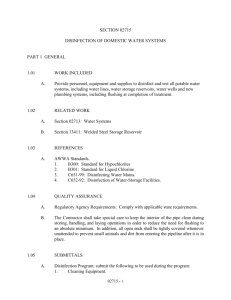
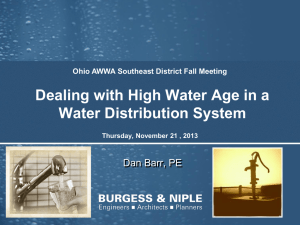




![[1] - Boswellsgmt](http://s3.studylib.net/store/data/006603407_1-fadfbce8d94050a9fb3c38a07d86e8ee-300x300.png)

